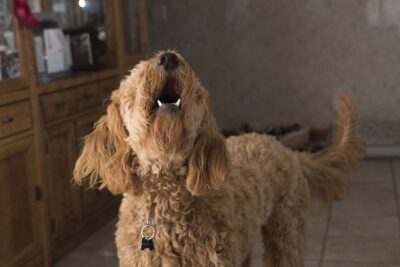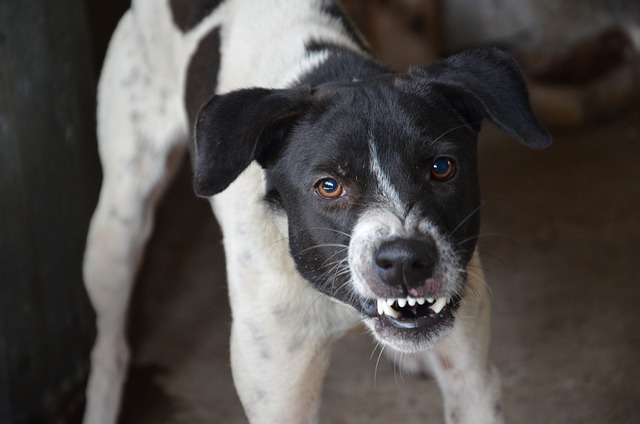



Dealing with an aggressive dog can be a challenging and sometimes overwhelming experience. Aggression in dogs can manifest in various ways, such as growling, barking, lunging, or even biting. It is essential to understand that aggression is a complex behavior that can have multiple underlying causes.
Aggression in dogs can be caused by fear, anxiety, territoriality, possessiveness, or even medical conditions. It is crucial to identify the root cause of the aggression to develop an effective plan for managing and modifying the behavior.
If you are dealing with an aggressive dog, it is recommended to consult with a professional dog behaviorist or a certified dog trainer who specializes in aggression. They can help assess the situation, provide guidance, and develop a customized behavior modification plan for your dog.
When dealing with an aggressive dog, seeking professional help is highly recommended. A professional dog behaviorist or trainer can provide valuable insights and guidance on how to address the aggression effectively.
They will assess your dog's behavior, identify triggers, and develop a behavior modification plan tailored to your dog's specific needs. They can also teach you techniques and strategies to manage and modify your dog's aggressive behavior.
Remember, aggression in dogs can be dangerous, and it is essential to prioritize safety for both you and your dog. A professional can help you navigate through this challenging situation and ensure the well-being of everyone involved.
Creating a safe environment is crucial when dealing with an aggressive dog. It is essential to prevent situations that may trigger your dog's aggression and ensure the safety of everyone in your household.
Start by identifying potential triggers for your dog's aggression. This could be certain people, other animals, specific objects, or even specific situations. Once you have identified the triggers, take steps to minimize or eliminate exposure to them.
For example, if your dog becomes aggressive when encountering other dogs, avoid areas where you are likely to encounter them. If your dog becomes aggressive when people approach their food bowl, feed them in a separate room where they can eat undisturbed.
Additionally, make sure your home is secure and that your dog cannot escape or harm themselves or others. Use baby gates or crates to create safe spaces where your dog can relax without feeling threatened.
Behavior modification techniques are an essential part of dealing with an aggressive dog. These techniques aim to change your dog's emotional response to triggers and teach them alternative behaviors.
One common behavior modification technique is desensitization and counterconditioning. This involves gradually exposing your dog to their triggers at a distance where they do not display aggression and pairing it with positive experiences, such as treats or play. Over time, your dog will learn to associate their triggers with positive outcomes, reducing their aggressive response.
Another technique is teaching your dog alternative behaviors to replace their aggressive reactions. For example, teaching your dog to sit or lie down when they encounter a trigger can redirect their focus and help them remain calm.
It is important to note that behavior modification takes time and patience. Consistency and positive reinforcement are key to success. Work with a professional to develop a behavior modification plan and follow it diligently.
Consistency and positive reinforcement are crucial when dealing with an aggressive dog. Dogs thrive on routine and clear expectations, so it is important to establish consistent rules and boundaries.
Use positive reinforcement techniques, such as treats, praise, and play, to reward your dog for calm and non-aggressive behavior. This will help reinforce the desired behavior and motivate your dog to continue behaving appropriately.
Avoid punishment-based training methods, as they can escalate aggression and damage the trust between you and your dog. Instead, focus on rewarding good behavior and redirecting your dog's attention away from triggers.
Consistency is also important when it comes to implementing behavior modification techniques. Stick to the plan developed with your professional and ensure that everyone in your household follows the same guidelines. This will help your dog understand what is expected of them and promote a more stable and predictable environment.
Managing triggers and avoiding provocation is essential when dealing with an aggressive dog. By identifying and understanding your dog's triggers, you can take steps to minimize their exposure to them.
Avoid putting your dog in situations where they are likely to become aggressive. This may mean avoiding crowded places, keeping them away from unfamiliar dogs or people, or creating a safe space for them when visitors come to your home.
It is also important to avoid provoking your dog. This means not engaging in activities that may trigger their aggression, such as rough play or teasing. Respect your dog's boundaries and provide them with a calm and predictable environment.
If you are unsure about how your dog will react in a particular situation, it is best to err on the side of caution and take steps to prevent any potential aggression.
Regular exercise and mental stimulation are important for all dogs, including those with aggression issues. Physical exercise helps release excess energy and promotes overall well-being, while mental stimulation keeps your dog's mind engaged and prevents boredom.
Engage in daily exercise routines with your dog, such as walks, runs, or play sessions. This will help burn off excess energy and reduce the likelihood of your dog becoming frustrated or anxious, which can contribute to aggression.
In addition to physical exercise, provide your dog with mental stimulation. This can include puzzle toys, interactive games, or training sessions. Mental stimulation helps keep your dog's mind occupied and can redirect their focus away from potential triggers.
Remember to tailor the exercise and mental stimulation to your dog's individual needs and abilities. Consult with a professional to determine the appropriate amount and type of activities for your dog.
When dealing with an aggressive dog, it may be necessary to use tools and equipment to manage their behavior. However, it is important to use these tools safely and responsibly.
Tools such as head halters or no-pull harnesses can provide better control during walks and help prevent your dog from pulling or lunging. Muzzles can also be used to prevent biting in situations where your dog may feel threatened or anxious.
It is crucial to introduce these tools gradually and ensure that your dog is comfortable wearing them. Consult with a professional to learn how to properly use and fit these tools to avoid causing any harm or discomfort to your dog.
Remember, tools and equipment should be used as a temporary management solution while you work on behavior modification techniques. They should not be relied upon as a long-term solution or a substitute for professional help.
Dealing with an aggressive dog requires education and training for the owners as well. Understanding dog behavior, body language, and communication is essential in effectively managing and modifying aggression.
Take the time to educate yourself about dog behavior and aggression. Read books, attend seminars, or enroll in training courses that focus on aggression and behavior modification. The more knowledge you have, the better equipped you will be to help your dog.
Additionally, consider working with a professional dog trainer or behaviorist who can provide guidance and support. They can teach you techniques and strategies to manage your dog's aggression and help you develop the necessary skills to handle challenging situations.
Remember, dealing with an aggressive dog can be emotionally draining, and it is important to take care of yourself as well. Seek support from friends, family, or support groups who understand what you are going through.
Monitoring your dog's progress and seeking ongoing support is crucial when dealing with an aggressive dog. Behavior modification takes time, and it is important to track your dog's improvements and make adjustments to your plan as needed.
Keep a journal or record of your dog's behavior, noting any triggers, improvements, or setbacks. This will help you identify patterns and make informed decisions about your dog's training and management.
Stay in regular contact with your professional dog behaviorist or trainer. They can provide guidance, monitor progress, and make necessary adjustments to your behavior modification plan.
Remember, dealing with an aggressive dog can be a long-term process, and it is important to remain patient and committed. With the right approach, consistency, and professional guidance, you can help your dog overcome their aggression and live a happier, more balanced life.
Related posts